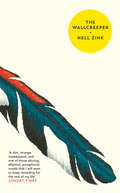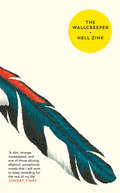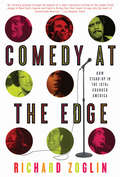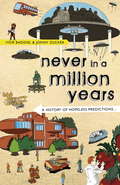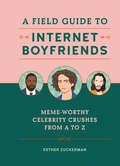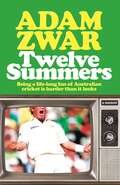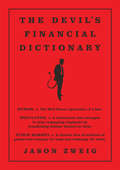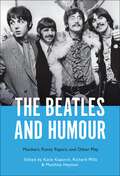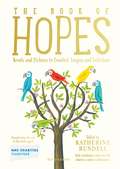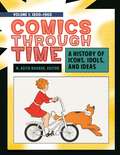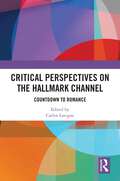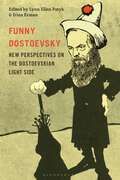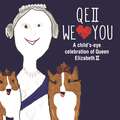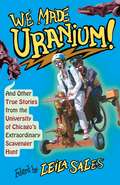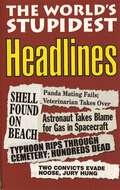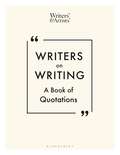- Table View
- List View
The Wallcreeper: The Nell Zink Collection
by Nell Zink‘Heady and rambunctious … Wake up, this book says: in its plot lines, in its humour, in its philosophical underpinnings and political agenda. I'll pay it the highest compliment it knows – this book is a wild thing.’ New York Times Book Review
The Wallcreeper: The Nell Zink Collection
by Nell Zink‘Heady and rambunctious … Wake up, this book says: in its plot lines, in its humour, in its philosophical underpinnings and political agenda. I'll pay it the highest compliment it knows – this book is a wild thing.’ New York Times Book Review
Comedy at the Edge: How Stand-up in the 1970s Changed America
by Richard ZoglinWhen Lenny Bruce overdosed in 1966, he left behind an impressive legacy of edgy, politically charged comedy. Four short years later, a new breed of comic, inspired by Bruce's artistic fearlessness, made telling jokes an art form, forever putting to rest the stereotype of the one-liner borscht belt set. During the 1970s, a small group of brilliant, iconoclastic comedians, led by George Carlin, Richard Pryor, and Robert Klein, tore through the country and became as big as rock stars in an era when Saturday Night Live and SCTV were the apotheosis of cool, and the Improv and Catch a Rising Star were the hottest clubs around. That a new wave of innovative comedians, like Steve Martin, Albert Brooks, Robin Williams, and Andy Kauffman followed closely behind only cemented comedy's place as one of the most important art forms of the decade. In Comedy at the Edge, Richard Zoglin explores in depth this ten-year period when comedians stood, with microphone in hand, at the white-hot center of popular culture, stretching the boundaries of the genre, fighting obscenity laws, and becoming the collective voices of their generation. In the process, they revolutionized an art form. Based on extensive interviews with club owners, booking agents, groupies, and the players themselves, Zoglin traces the decade's tumultuous arc in this no-holds barred, behind-the-scenes look at one of the most influential decades in American popular culture.
Never In A Million Years: A History of Hopeless Predictions
by Jonny Zucker Ivor BaddielThe authors of the bestselling NOT THE HIGHWAY CODE shine a light on the extensive back catalogue of dodgy predictions through the ages.The first end of the world prediction was recorded one second after the Big Bang and since then it has become the daddy of all predictions with, to date, no one getting it right. And human beings have been around for about 200,000 years, with very little evolutionary difference, and yet we still haven't developed X-Ray eyes or the ability to fly.In this book, Baddiel and Zucker examine the predictions that have been made since the dawn of time on a variety of subjects, from the end of the world and the human body, to global warming, robots in the workplace, teleportation and space exploration. With a witty and fresh tone, they examine how these predictions came about and why, and rate them for retrospective accuracy.
A Field Guide to Internet Boyfriends: Meme-Worthy Celebrity Crushes from A to Z
by Esther ZuckermanFrom Keanu Reeves and Idris Elba to Timothe Chalamet, A Field Guide to Internet Boyfriends is the ultimate celebration of the suave, sexy, sensitive, and silly celebrities who have captured our hearts and memes! Handsome and heartfelt, with winning smiles and pinnable Tweets -- this is what Internet Boyfriends are made of. But who are these meme-able men, and what makes them catch fire online? Discover the answers to these questions and more in A Field Guide to Internet Boyfriends, an interactive exploration of our collective crushes. Entertainment journalist Esther Zuckerman breaks down the world of Internet Boyfriends -- and even a few Internet Girlfriends -- from documentary-style "spotting guides" to discussions on the key categories of boyfriend, like Sensitive Souls, Beautiful Boys and Daddys. A playful, teen magazine-style quiz -- to help readers find their ideal crush -- and in-depth profiles of some of the most beloved Internet Boyfriends and Girlfriends, from Ryan Gosling (the original) to Harry Styles (the Gen Z icon) to Janelle Monae (the space queen), round out this fully-illustrated romp through the celebs behind the memes.
Twelve Summers
by Adam ZwarCricket fans, where were you during the disaster that was the 2013 Ashes? Adam Zwar was making a documentary about bodyline and filming a stunt that involved Brett Lee bowling bouncers to him while he wasn't wearing a helmet. Matthew Hayden warned him not do it. But the cameras were set up. What was he going to do - say no?How about when Australia A nearly upset Australia in the 1995 World Series Cup and the players were rebelling against officials? Adam was working as a driver for an escort agency in Melbourne.Or Australia v India in 2001? That was when Adam was stuck in a hotel with AC/DC. For all the significant moments in Adam's life, cricket was in the background - or foreground. And you don't need to be a fan of cricket to be able to relate, because we all remember where we were when something important happened, whether that's a cricket test, an album release or a TV show ending. Twelve Summers is hilarious, moving and thought provoking. Even if you aren't a fan of cricket, you'll find a lot to love in this book.
The Devil's Financial Dictionary
by Jason ZweigYour Survival Guide to the Hades of Wall StreetThe Devil's Financial Dictionary skewers the plutocrats and bureaucrats who gave us exploding mortgages, freakish risks, and banks too big to fail. And it distills the complexities, absurdities, and pomposities of Wall Street into plain truths and aphorisms anyone can understand.An indispensable survival guide to the hostile wilderness of today's financial markets, The Devil's Financial Dictionary delivers practical insights with a scorpion's sting. It cuts through the fads and fakery of Wall Street and clears a safe path for investors between euphoria and despair.Staying out of financial purgatory has never been this fun.
The Devil's Financial Dictionary
by Jason ZweigYour Survival Guide to the Hades of Wall StreetThe Devil's Financial Dictionary skewers the plutocrats and bureaucrats who gave us exploding mortgages, freakish risks, and banks too big to fail. And it distills the complexities, absurdities, and pomposities of Wall Street into plain truths and aphorisms anyone can understand. An indispensable survival guide to the hostile wilderness of today's financial markets, The Devil's Financial Dictionary delivers practical insights with a scorpion's sting. It cuts through the fads and fakery of Wall Street and clears a safe path for investors between euphoria and despair. Staying out of financial purgatory has never been this fun.
The Beatles and Humour: Mockers, Funny Papers, and Other Play
The Beatles are known for cheeky punchlines, but understanding their humor goes beyond laughing at John Lennon's memorable “rattle your jewelry” dig at the Royal Variety Performance in 1963. From the beginning, the Beatles' music was full of wordplay and winks, guided by comedic influences ranging from rhythm and blues, British radio, and the Liverpool pub scene. Gifted with timing and deadpan wit, the band habitually relied on irony, sarcasm, and nonsense. Early jokes revealed an aptitude for improvisation and self-awareness, techniques honed throughout the 1960s and into solo careers. Experts in the art of play, including musical experimentation, the Beatles' shared sense of humor is a key ingredient to their appeal during the 1960s- and to their endurance.The Beatles and Humour offers innovative takes on the serious art of Beatle fun, an instrument of social, political, and economic critique. Chapters also situate the band alongside British and non-British predecessors and collaborators, such as Billy Preston and Yoko Ono, uncovering diverse components and unexpected effects of the Beatles' output.
The Book of Hopes: Words and Pictures to Comfort, Inspire and Entertain
In difficult times, what children really need is hope. And in that spirit, bestselling author Katherine Rundell emailed some of the children's writers and artists whose work she loved most:'I asked them to write something very short, fiction or non-fiction, or draw something that would make the children reading it feel like possibility-ists: something that would make them laugh or wonder or snort or smile. The response was magnificent, which shouldn't have surprised me, because children's writers and illustrators are professional hunters of hope… I hope that the imagination can be a place of shelter for children and that The Book of Hopes might be useful in that, even if only a little.'This collection, packed with short stories, poems and pictures from the very best children's authors and illustrators, aims to provide just that. Within its pages you'll find animal friends from insects to elephants, high-flying grandmas, a homesick sprite, the tooth fairy, and even extra-terrestrial life.There are 133 contributions from authors and illustrators, including Anthony Horowitz, Axel Scheffler, Catherine Johnson, Jacqueline Wilson, Katherine Rundell, Lauren Child, Michael Morpurgo and Onjali Q. Raúf. A donation from the sale of each book will go to NHS Charities Together, in gratitude for the incredible efforts of all those who worked in hospitals over the quarantine period.'An anthology on the theme of hope… it includes a rich range of images, poetry, stories and non-fiction' Stories to charm on endless days, The Sunday TimesThe following proceeds from this ebook will be donated to NHS Charities Together: 35% of publisher's net receipts or at least £1.00 per copy.NHS Charities Together is a charity registered in England and Wales (registered charity no. 1186569)
Comics through Time [4 volumes]: A History of Icons, Idols, and Ideas [4 volumes]
Focusing especially on American comic books and graphic novels from the 1930s to the present, this massive four-volume work provides a colorful yet authoritative source on the entire history of the comics medium.Comics and graphic novels have recently become big business, serving as the inspiration for blockbuster Hollywood movies such as the Iron Man series of films and the hit television drama The Walking Dead. But comics have been popular throughout the 20th century despite the significant effects of the restrictions of the Comics Code in place from the 1950s through 1970s, which prohibited the depiction of zombies and use of the word "horror," among many other rules. Comics through Time: A History of Icons, Idols, and Ideas provides students and general readers a one-stop resource for researching topics, genres, works, and artists of comic books, comic strips, and graphic novels. The comprehensive and broad coverage of this set is organized chronologically by volume. Volume 1 covers 1960 and earlier; Volume 2 covers 1960–1980; Volume 3 covers 1980–1995; and Volume 4 covers 1995 to the present. The chronological divisions give readers a sense of the evolution of comics within the larger contexts of American culture and history. The alphabetically arranged entries in each volume address topics such as comics publishing, characters, imprints, genres, themes, titles, artists, writers, and more. While special attention is paid to American comics, the entries also include coverage of British, Japanese, and European comics that have influenced illustrated storytelling of the United States or are of special interest to American readers.
Critical Perspectives on the Hallmark Channel: Countdown to Romance
This multinational, multidisciplinary collection of essays focuses on Hallmark Channel movies and Hallmark’s position in the changing North American media landscape.This book covers the ‘Countdown to Christmas’ offerings, year-round productions, made-for-TV mysteries and romances, Hallmark’s use of specific filming locations, and its relationship to viewer desires. Chapters examine Hallmark’s position in a changing sociopolitical context and the tensions the company must navigate in creating more “progressive” content; they discuss issues of gender, race, sexuality, and place, as well as analyzing the extensive ranges and reactions of social media participants and interrogating the nature of Hallmark’s popularity.Suitable for scholars and students of film and tv and popular culture studies, this is a multifaceted look at both Hallmark and its viewers at a particular moment of Hallmark’s market dominance.
Funny Dostoevsky: New Perspectives on the Dostoevskian Light Side
Tapping into the emergence of scholarly comedy studies since the 2000s, this collection brings new perspectives to bear on the Dostoevskian light side. Funny Dostoevksy demonstrates how and why Dostoevsky is one of the most humorous 19th-century authors, even as he plumbs the depths of the human psyche and the darkest facets of European modernity. The authors go beyond the more traditional categories of humor, such as satire, parody, and the carnivalesque, to apply unique lenses to their readings of Dostoevsky. These include cinematic slapstick and the body in Crime and Punishment, the affective turn and hilarious (and deadly) impatience in Demons, and ontological jokes in Notes from Underground and The Idiot. The authors – (coincidentally?) all women, including some of the most established scholars in the field alongside up-and-comers – address gender and the marginalization of comedy, culminating in a chapter on Dostoevsky's "funny and furious" women, and explore the intersections of gender and humor in literary and culture studies. Funny Dostoevksy applies some of the latest findings on humor and laughter to his writing, while comparative chapters bring Dostoevsky's humor into conjunction with other popular works, such as Chaplin's Modern Times and Lin-Manuel Miranda's Hamilton. Written with a verve and wit that Dostoevsky would appreciate, this boldly original volume illuminates how humor and comedy in his works operate as vehicles of deconstruction, pleasure, play, and transcendence.
Humor in Global Contemporary Art
Pursuing a new and timely line of research in world art studies, Humor in Global Contemporary Art is the first edited collection to examine the role of culturally specific humor in contemporary art from a global perspective.Since the 1960s, increasing numbers of artists from around the world have applied humor as a tool for observation, critique, transformation, and debate. Exploring how humorous art produced over the past six decades is anchored in local sociopolitical contexts and translated or misconstrued when exhibited abroad, this book opens new conversations regarding the functioning of humor and the ways in which art travels across the globe. With contributions by an impressive array of internationally based scholars covering six major continental regions, the book is organized into four distinct geographical sections: Africa and the Middle East, Asia and Oceania, South and North America, and Europe. This structure highlights the cultural specificity of each region while the book as a whole offers a critical perspective on the postcolonial, globalized art network.Reflecting on present-day processes of globalization and biennialization, which confront viewers with humorous art from a variety of cultures and countries, this book will provide readers with a culturally sensitive understanding of how humor has become vital to many contemporary artists working in an unprecedentedly interconnected world.
QEII We Love You: A Child's-eye Celebration of Queen Elizabeth II
Children answer questions about the Queen in this delightful tribute to our longest-serving monarch and celebration of the innocence of childhood.In September 2015 Queen Elizabeth became Britain's longest-reigning monarch, a position previously held by her great-great-grandmother, Queen Victoria. In this wonderful celebration of her reign, primary school children offer their charming and often hilarious views on the Queen, her life, her work and her corgis.Answering a variety of questions, such as 'What does the Queen do all day?', 'Where does the Queen like to go on holiday?' and 'What does the Queen like to watch on television?', children offer their insights into the Queen's life.Learn how she apparently likes to play with her corgis in the park, sit on her throne while reading the newspaper and drinking wine, watch all the soaps on TV and how she spends her working days waving to people and attending meetings. These entertaining and funny answers are accompanied throughout by the children’s highly imaginative drawings of the Queen.Published to coincide with this landmark occasion, this wonderful book is a tribute to our longest-serving monarch, and celebrates both her reign and the innocence of childhood.
Television Sitcom and Cultural Crisis (Routledge Advances in Television Studies)
This volume demonstrates that television comedies are conduits through which we might resist normative ways of thinking about cultural crises.By drawing on Gramscian notion of crisis and the understanding that crises are overlapping, interconnected, and mutually constitutive, the essays in this collection demonstrate that situation comedies do more than make us laugh; they also help us understand the complexities of our social world’s moments of crisis. Each chapter takes up the televisual representation of a modern cultural crisis in a contemporary sitcom and is grounded in the extensive body of literature that suggests that levity is a powerful mechanism to make sense of and cope with these difficult cultural experiences.Divided into thematic sections that highlight crises of institutions and systems, identity and representation, and speculation and futurism, this book will interest scholars of media and cultural studies, political economy, communication studies, and humor studies.
We Made Uranium!: And Other True Stories from the University of Chicago's Extraordinary Scavenger Hunt
Item #176: A fire drill. No, not an exercise in which occupants of a building practice leaving the building safely. A drill which safely emits a bit of fire, the approximate shape and size of a drill bit. Item #74: Enter a lecture class in street clothes. Receive loud phone call. Shout “I NEED TO GO, THE CITY NEEDS ME!” Remove street clothes to reveal superhero apparel. Run out for the good of the land. Item #293: Hypnotizing a chicken seems easy, but if the Wikipedia article on the practice is to be believed, debate on the optimal method is heated. Do some trials on a real chicken and submit a report . . . for science of course. Item #234: A walking, working, people-powered but preferably wind-powered Strandbeest. Item #188: Fattest cat. Points per pound. The University of Chicago’s annual Scavenger Hunt (or “Scav”) is one of the most storied college traditions in America. Every year, teams of hundreds of competitors scramble over four days to complete roughly 350 challenges. The tasks range from moments of silliness to 1,000-mile road trips, and they call on participants to fully embrace the absurd. For students it is a rite of passage, and for the surrounding community it is a chance to glimpse the lighter side of a notoriously serious university. We Made Uranium! shares the stories behind Scav, told by participants and judges from the hunt’s more than thirty-year history. The twenty-three essays range from the shockingly successful (a genuine, if minuscule, nuclear reaction created in a dorm room) to the endearing failures (it’s hard to build a carwash for a train), and all the chicken hypnotisms and permanent tattoos in between. Taken together, they show how a scavenger hunt once meant for blowing off steam before finals has grown into one of the most outrageous annual traditions at any university. The tales told here are absurd, uplifting, hilarious, and thought-provoking—and they are all one hundred percent true.
The World's Stupidest Headlines
This is an entertaining collection of the world's stupidest headlines, featuring over 300 examples of the most ludicrous headlines ever to be printed in newspapers throughout the world. At first glance they might seem perfectly reasonable, but on closer inspection their implied meaning can be something else entirely ... and it's not always pretty.
Writers on Writing: A Book of Quotations (Writers' and Artists')
Writers on Writing brings together a plethora of phrases, quotable lines, quips and putdowns about the writing process. Arranged in themes that follow the stages from idea to final publication and beyond, this little book of quotations brings together words of wisdom and withering wit from famous and infamous writers across the ages about their own work and that of fellow writers. Themes on the publishing process include: getting started, first drafts, agents, editing, publication day, book tours; and on different genres, forms and writing styles, such as plot, character, dialogue. Other topics covered are: rivals, censorship, writer's block, spelling, fame, money, plagiarism, and alcohol. The quotations are accompanied by their original source (where known), date and a short writer biographical note. ''A writer is a person who writes.'' John Braine ''Our book is found to be a drug, no man needs it or heeds it. In the space of a year our publisher has disposed but of two copies.'' Charlotte Brontë ''How rare, how precious is frivolity! How few writers can prostitute all their powers! They are always implying, 'I am capable of higher things'.'' E.M. Forster
